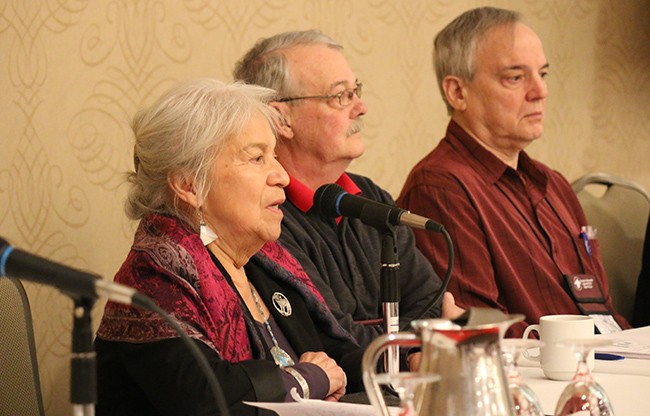We cannot become extinct: Implementation of our E-Dbendaagzijig has to happen now

By Marci Becking
SAULT STE MARIE – Anishinabek Nation Citizenship Commissioner Jeannette Corbiere-Lavell says that she is pleased that we are at this point in our history when the Anishinabek Nation passed resolutions that we want to retain our people no matter where they are.
E-Dbendaagzijig – those who belong – is the Anishinabek Nation Citizenship Law.
“We have inherent rights, we are a sovereign nation,” says Corbiere-Lavell. “Our people recognize each other. E-Dbendaagzijig says that if you can trace your ancestry to either parent – to someone that is Anishinaabe – then you are eligible to be a member of the Anishinabek Nation. Or, you can also trace it back in the Indian Act way to be a Status Indian. One-parent rule. No complications that the Indian Act has now. That is what is tearing our communities apart. I was able to get my status back to my community and my children were able to. The actions that are happening with the Indian Act is so piecemeal. We need dollars to do the implementation. We know who our people are. If we believe what we are being taught – have our teachings – be Anishinaabe in our teachings, then we are Anishinaabe.”
Deputy Grand Council Chief Glen Hare says that from the Jeremy Hull and Stewart Clatworthy’s report, we need to implement E-Dbendaagzijig in our communities to make us stronger.
“There will be more of us. Today as we stand hear today we are getting beaten by the white man,” says Hare. “Today another child is being taken away in the hospitals when they are born. When I talk to government I tell them we have a law that says we have people that belongs to us. We can’t stop our children from dating non-native people. Miigwetch to Jeannette for her fight for us. When we fought for the Robinson-Huron annuities in the early days – they told us you’re not Anishinaabe – not treaty Indian. That’s almost like Indian Affairs telling us that. I don’t know the difference between Anishinaabe and Treaty Indians.”
“We should be proud when our kids find a partner and have kids to make our Nation strong.”
Grand Council Chief Patrick Madahbee says that the “Indian problem” goes back to the time of Sir John A. Macdonald.
“All the policies and legislation is to try to get rid of the Indian Problem,”says Madahbee. “In Missisaugas of Scugog – as of 2013 no more registered Indians. Italy, Japan, China, the UK, Germany, France – everyone else has the one parent rule to recognize their people. Everywhere around the world.”
“We cannot to afford to lose one more Anishinaabe. Implementation needs to start. I urge all First Nations to implement that law in their communities. We cannot become extinct.”
Report data:
84% of people who live in our First Nations are status – 3% are Aboriginal identity and 13% are non-First Nation.
Between 2002 and July 2016, the Registered Indian population of Anishinabek First Nations increased by 14,820 (or about 32%) to 61, 360 individuals. 21,558 on reserve, 39,802 off reserve.
Language – 19.1% Lake Huron – 3.6% Lake Superior, 3% Southwest and 5.7% Southeast mother tongue Anishinaabemowin
Top home language use in individual communities: Wikwemikong 20.4%, Sagamok Anishinawbek 9.2%, Beausoleil 5.7%, M’Chigeeng 5.6%, Sheshegwaning 3.7%, Pic River 3.4%, Andeck Omni Kaning2.7%, Whitefish River 2.2%, Curve Lake 1.9% , Wasauksing 1.6%, Nipissing .9%, Garden River .9%, Aamjiwnaang .8% and Rama .6%.
Percentage of language speakers in 1996 – 19% down to 7% in 2016.


